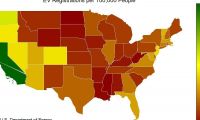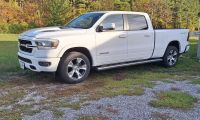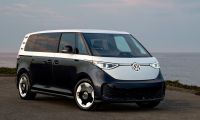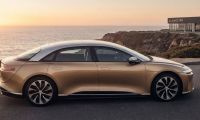As most TorqueNews readers know, this reporter has focused intently on automotive technology during 2011. So, it is fitting that I first address the criteria by which the Buick eAssist™ was chosen among the many fine technologies that were in this year’s running.
1) The technology has to be in production and preferably new technology within the past two years.
2) The technology has to contribute to the betterment of the automobile in the area of green; in other words, at least contribute to the lessening of CO2 emissions.
3) The technology has to contribute to the efficiency of the automobile, preferably in the saving of fuel.
4) The technology must be cost competitive; meaning, it has to be affordable by the masses and preferably not require government subsidies to support sales.
In the Running
Many technologies have contributed to the improvement of the automobile in 2011. However, while the electrification of the car has taken center stage on many blogs and magazines, the IC engine has not fully finished its usefulness. So, the following runners for this year’s Best of Best Production Auto Technology 2011 included both EV related and ICE. The list follows:
Ford EcoBoost: Ford has taken a tech direction with the IC engine that shows practicality in every way. First it chosen to decrease the volume of the engine to reduce CO2. Furthermore, it has opted to replace the power lost by the volume reduction by replenishing that with pressure boosting technology, such as turbo charging. In the case of the V6 EcoBoost, that engine has twin turbochargers.
Stop-Start Technology: Many auto companies engage this technology, including Ford and General Motors along with many others. Furthermore, it avails the use of many other tech components like multi-valves, variable valve timing, variable cam phasing, etc. which have been around for few years now. Nonetheless, an entire engine that shuts down is one that does not pollute; and it saves on fuel.
Cylinder Shut-Off Technology: Much like Stop-Start, many auto companies are now engaging this technology, including Ford and General Motors along with many others, whereby select cylinders of a multi-cyclinder engine are liertall shot off from fuel. It competes heavily on cost with hybrids. Furthermore, it avails the use of many other tech components like multi-valves, variable valve timing, variable cam phasing, etc. which have been around for few years now. Nonetheless, a cylinder that shuts down is one that does not pollute; and it saves on fuel.
GM Voltec Propulsion: Electrification of the automobile comes in many forms from full to partial. The Voltec Propulsion technology, although using taxpayer subsidies, does not need them. It avails the use of full battery-supplied electrification for 40 miles, then switches over to an IC engine generator to charge the battery. Aside from a special condition at high speeds, the wheels are driven the majority of the time by a electric motor. The one drawback that will remain for 2012 will be the cost and the need for subsidies.
Buick eAssist™: This technology is classified as a lighter version of electrification for the automobile. At low speeds, the technology allows an electric motor to act as startup for the engine during cylinder shut-off, and as an electric drive motor for the express purpose of improving city driving for medium to larger vehicles.
The Full EV: It was obvious from the 2011 NAIAS in Detroit that the EV had entered mainstream. It was no longer relegated to the basement or to advance vehicle displays of the future. The introduction of the Nissan Leaf into production in 2011, which this reporter has driven along with many others, says it all. The EV is here to stay, but the subsides will have to go to get this award next year.
Toyota Prius: Already an awarded vehicle, was selling well before subsides ever came out. In fact, this writer believes that the Prius is the reason that pressure stayed firm on the auto industry to electrify. Although a hybrid, its use of the best technological combination, including its IC engine based on the Atkinson Cycle makes this selection an absolute necessity if for no other reason but respect.
And the 2011 Selection Is: Buick eAssist™
The Buick eAssist™ was chosen by this writer for a host of reasons. It met all the criteria, but, more important, it met the requirement with a cost basis that is affordable. In addition, the technology is scalable, meaning it can be tailored to fit other vehicles, large and small. Finally, it contributes where we best need the efficiency - city driving.
True, the Prius does that, too; so does the Chevy Volt and the Nissan Leaf. However, according to GM‘s Buick Division, the eAssist™ technology is unique in that it combines simple ideas and innovative technology to make 36 MPG HWY a reality on the road for larger vehicles which Americans prefer to drive. That means you can enjoy more time driving and fewer stops at the pump.
Buick’s innovative eAssist Technology improves your vehicle’s fuel efficiency by adding a compact electric motor and state-of-the-art lithium-ion battery to a 2.4L four-cylinder ECOTEC engine, improving fuel economy by an estimated 25%. The 2012 LaCrosse and Regal are the first vehicles available with eAssist Technology.
Here’s how it works: The key feature of the eAssist is that it is classified as a very mild hybrid setup. An electric motor/generator sits where the alternator normally would be. The four-cylinder gas engine turns the motor/generator via a beefed-up "fan belt." And the motor/generator can turn the engine (and, thus, help propel the car) via the same belt.
The eAssist electric motor also runs on the highway when needed, For example: It is touted to add 15 horsepower when passing or scooting up a freeway ram. It also can propel the car alone momentarily, as when pulling away from a stoplight.
In typical reverse fashion, the motor turns into a generator on deceleration and braking, recharging the small-size lithium-ion battery pack located in the trunk. Furthermore, like other hybrids, the eAssist system stops the gasoline engine from idling when you're at a long light or otherwise halted. The engine stays off up to two minutes, until you lift off the brake pedal and the engine restarts.
Final Comments
Whether you agree with this TN writer’s selection for 2011, be apprised that all the technologies listed are fully recognized and highly respected. It was appraised as the best overall value of the list and the most scalable technology factor which weighted the decision. Your opinions and comments are surely welcome.
[Photo Source: Frank Sherosky at SAE World Congress 2011 in Detroit. The photo shows the General Motors (NYSE: GM) display of eAssist™ at the SAE 2011 World Congress in Detroit. This is considered a mild form of vehicle electrification when compared to the Chevrolet Volt and other full hybrids.]
-----------------------
About the Reporter: After 39 years in the auto industry as a design engineer, Frank Sherosky now trades stocks, futures and writes articles, books and ebooks like, "Perfecting Corporate Character," "Awaken Your Speculator Mind", and "Millennial World Order" via authorfrank.com. He may be contacted here by email: [email protected] and followed in Twitter under @Authorfranks
________________________________________________
Additional Reading:
Buick LaCrosse with eAssist on par with highway fuel economy of compacts
The 2013 Chevrolet Malibu unveiled at the NYIAS
Auto industry compromise with expensive EVs fails the masses
Scuderi Air-Hybrid Engine technology setting up to challenge electric hybrids
Cella Energy achievement may make hydrogen fill-up a reality
Stop-start technology to advance more micro hybrids by 2016
Four alternate engine technologies for 2011 and beyond










